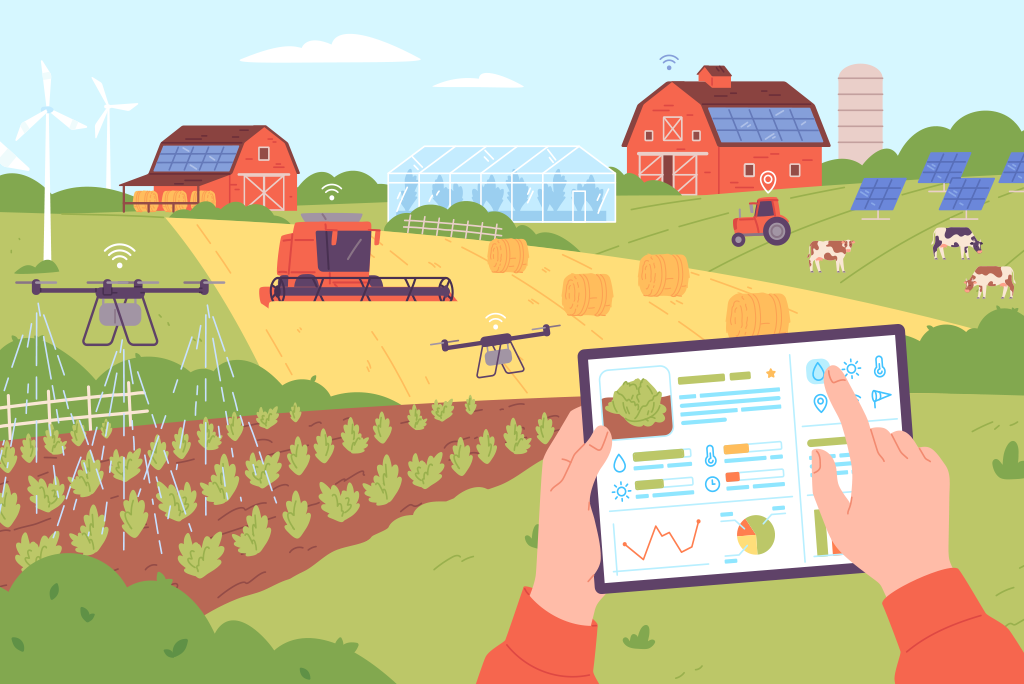
In order to support a growing population, many farmers are turning to new technologies. Smart farming uses information and communication technologies, such as the Internet of Things (IoT), robotics, and augmented and virtual realities (AR/VR), to improve both the quantity and quality of products while optimizing human labor.
Innovation in the Agriculture Industry
Also called “precision farming”, “smart agriculture”, and “Agriculture 4.0”, smart farming offers farmers a number of high tech techniques that can provide valuable data to assist in making decisions. It can also help ease their day-to-day work. Learn about some of the currently available technologies.
Sensors
By monitoring soil, water, light, humidity, or temperature management, IoT sensors can provide real-time data on key factors for crop yields. For example, farmers can analyze soil data to determine which specific areas of their fields need fertilizer rather than spreading it more evenly across hundreds of acres. Some sensors can also predict weather patterns or be used to automate smart greenhouses.
Robotics
By 2025, an estimated 80 percent of drone sales will be for agricultural use. Current applications include crop monitoring, spraying weeds, land surveying, and seeding. These drones can collect multispectral, thermal, and visual imagery in order to provide farmers with a wide variety of valuable data.
Connected Vehicles
John Deere, a leading farming equipment company, is working on self-driving tractors. And smart tractors don’t have to be unmanned or fully autonomous to benefit farmers. One particular feature called autosteering saves farmers time. According to Kevin Butt, a professor of agriculture at Ellsworth Community College in Iowa, autosteering can also improve farmers’ mental health as it requires less intense focus to operate. He reports that autosteering saves him several hours when planting a hundred-acre field while leaving him with enough mental energy to plant another field.
What’s Next in the Future of Farming?
The precision agriculture market is anticipated to reach US$43.4 billion by 2025. “For each kid in our program, five or six people in the agriculture industry want to hire them. There’s a job waiting for them,” says Professor Butt of his university’s agriculture program.
Learn more about this growing market by enrolling in Practical Applications of Virtual and Augmented Reality in Business and Society: Smart Agrofood Systems. This course from IEEE explores the use of virtual and augmented reality technologies within smart agriculture, such as agricultural robots and drones, as well as AR/VR mapping for sensors and global positioning systems. It also discusses agricultural production, cold chain logistics, infrastructure, and more.
Interested in the course? Visit the IEEE Learning Network.
Resources:
(22 June 2020). Smart Farming: The Future of Agriculture. IoT for all.
The Complete Guide to Smart Agriculture & Farming. Smarter Technologies.
Meola, Andrew. (2 February 2021). Smart Farming in 2020: How IoT sensors are creating a more efficient precision agriculture industry. Insider.
(21 December 2020). Smart Farming: The growing role of precision agriculture and biotech. Fast Company.
(24 November 2021). Agriculture 4.0: what is it and what are its tools and benefits? McCormick.


Like anything that has embedded intelligence, it relies heavily on the experienced acumen that led to the programming..
Read more on Smart Agriculture – Sustainable and Intelligent Phytoprotection, here: https://www.frontiersin.org/journals/plant-science/sections/sustainable-and-intelligent-phytoprotection